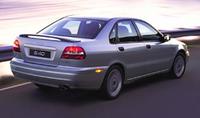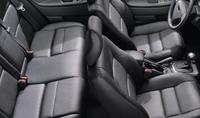Review 2004 Volvo S40 2.4I
THE AUTO PAGE
By
JOHN HEILIG
SPECIFICATIONS
MODEL: Volvo S40 2.4I, 5T
ENGINE (2.4I): inline 5-cylinder; (5T): turbocharged inline 5-cylinder
HORSEPOWER/TORQUE (2.4I): 168 hp @ 6,000 rpm/166 lb-ft @ 4,400 rpm
HORSEPOWER/TORQUE (5T): 218 hp @ 5,000 rpm/236 lb-ft @ 1,500-4,800 rpm
TRANSMISSION: 5/6-speed manual, 5-speed automatic
WHEELBASE: 103.9 in.
LENGTH x WIDTH x HEIGHT: 175.9 x 69.7 x 57.2 in.
STICKER PRICE: $24,000-$30,000 (est.)
To say I was impressed by the cool all-new Volvo S40 sedan is an understatement. The compact four-seater shares many components with the Mazda3, for example, although the two are built in different parts of the world. But other than some Ford family similarities, the two cars are different.
Volvo is touting the "cool all-new S40" as a way to attract a younger, more diverse audience. It is slated to compete with, among others, the Audi A4, VW Passat and Jetta, and the Acura TSX. Pricing ranges from around $24,000 to close to $30,000.
It just so happens that days before I drove the S40 I had a long trip in a TSX. The engines were of a similar size, 2.4 liters, and both had manual transmissions. But the Acura was a four and the Volvo a five-cylinder.
Maybe it was the inherent smoothness of a five-cylinder over a four, but the S40 had smoothness and quietness down pat. In the Acura there was considerable engine and wind noise; in the Volvo there was essentially none.
Two engines are available in the S40, and we had the opportunity to drive both with manual transmissions. We first drove the naturally aspirated 2.4i, with a 2.4-liter five-cylinder engine transversely mounted and driving the front wheels. This engine delivers 168 horsepower at 6,000 rpm and 166 lb.-ft. of torque at 4,400 rpm.
The T5 features a light turbocharged 2.5-liter five-cylinder engine that delivers 218 hp at 5,000 rpm and 235 lb.-ft. of torque between 1,500 and 4,800 rpm. I know this will sound strange coming from power-hungry me, but I liked both engines equally. Low-pressure turbocharging eliminates many of the problems associated with "normal" turbocharging, such as torque steer, etc., so the ride is much better. But even 168 horsepower is enough for a vehicle that weighs between 3,100 and 3,300 pounds.
At introduction, the S40 will be offered with an automatic transmission, with the manual available as a no-cost option. All-wheel drive will be available "later" on the T5.
The present generation S40 has a 170 hp 1.9-liter turbocharged four.
The Volvo and Acura are two cars that should be equal, but I felt the Volvo was the superior vehicle. The five-speed was easier to use (probably more my problem than the car's), although a six-speed is available in the turbocharged version.
I felt the Volvo handled better, as well. We drove both over a combination of Interstates and winding roads. The Volvo's roads were more challenging because they encompassed some of my favorite roads in the world, the canyons north of Los Angeles. The Acura took us over more familiar terrain down to Virginia, and the roads I generally use on that trek are less challenging.
We were able to throw the S40 around some tight, fast corners with full confidence that we were going to come out the other side in one piece. The front suspension is swing-strut, with a lower link and anti-roll bar. The rear suspension is multilink with coil springs and an anti-roll bar. It was stiff, in the way many European cars are stiff, but not too intrusive to allow for a comfortable ride.
I guess I should say something about the seats. They were thickly upholstered and held us in, no matter how hard the driver drove. And, being a Volvo, the S40 inspired confidence. Oddly, Volvo almost apologized because the seats were slightly thinner and narrower than the current-generation S40.
Of course, when you look at an S40, you immediately know it's a Volvo. There is the signature grille, of course, and the taillight lenses look as if they were lifted off an S80, with their prominent "shoulders." There's also a strong familiar character line that runs from the taillights forward to the front fenders. The grille-headlight area has a decided "V" shape to it.
In profile, the S40 retains some of the C60 coupe lines, but translated into a compact sedan. Volvo design has been transformed over the past few years, such that the old S40 looks stodgy and square.
Volvo said they wanted to keep the Volvo design language, but also make a car that's more youthful and exciting. Maybe that's why they chose 32-year-old Al Briscoe's design over two others.
Dimensionally, the new S40 has a wheelbase 3.1 inches longer than the car it replaces, is two inches shorter, two inches wider and 1.5 inches taller. It was designed for the American market.
Dominating the interior is a center stack that has a great deal of personality in its own right. It is designed to look a lot like a combination between a television remote and a portable phone. It has a keypad, but it also has normal volume and tuning controls for the radio, and a slot for the CD, and controls for the HVAC system. It can be configured to different design forms (plastic, wood, aluminum, etc.) to conform to the owner's choice. It's part of the philosophy that the car should be "customizable" to a certain extent.
Volvo's going to make a lot of friends with the "cool all-new S40." This is a solid vehicle at a decent price point that should make the competition start looking at what they're offering and start thinking how they can catch up.
Ain't it great to be a consumer some times?
(c) 2004 The Auto Page Syndicate




